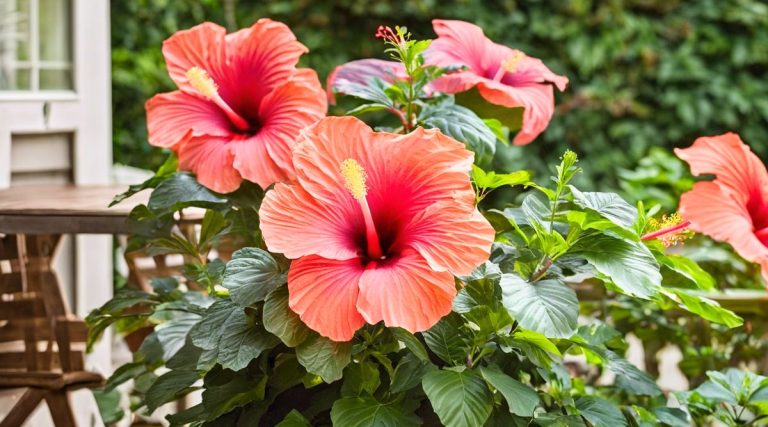Cutting Back Hibiscus: Expert Tips for Healthy, Vibrant Blooms
As a passionate gardener, I’ve always been captivated by the vibrant beauty of hibiscus plants. These tropical showstoppers can transform any garden into a colorful paradise. But did you know that proper pruning is key to maintaining their health and encouraging abundant blooms?
I’ve learned through years of experience that cutting back hibiscus isn’t just about aesthetics – it’s crucial for the plant’s overall well-being. Whether you’re dealing with hardy or tropical varieties, knowing when and how to prune can make all the difference. Are you ready to unlock the secrets of hibiscus pruning and take your garden to the next level? Let’s dive in and explore the art of cutting back these stunning flowers.
Understanding Hibiscus Plants
Hibiscus plants are diverse and captivating, with over 200 species in the Malvaceae family. They’re prized for their showy flowers and lush foliage, making them popular choices for gardens and landscapes.
Types of Hibiscus
Hibiscus plants come in three main types:
- Tropical hibiscus (Hibiscus rosa-sinensis):
- Large, colorful flowers
- Thrives in warm climates
- Often grown as houseplants in cooler regions
- Hardy hibiscus (Hibiscus moscheutos):
- Native to North America
- Survives cold winters
- Produces dinner plate-sized blooms
- Rose of Sharon (Hibiscus syriacus):
- Deciduous shrub
- Cold-hardy
- Smaller flowers than other types
Each type has unique characteristics and care requirements. I’ve found that tropical hibiscus are particularly sensitive to cold, while hardy hibiscus bounce back even after harsh winters.
Growing Habits and Bloom Cycles
Hibiscus plants exhibit varied growing habits and bloom cycles:
- Tropical hibiscus:
- Evergreen in warm climates
- Blooms year-round in ideal conditions
- Flowers last only 1-2 days
- Hardy hibiscus:
- Dies back to the ground in winter
- Blooms late summer to early fall
- Flowers can last 3-4 days
- Rose of Sharon:
- Deciduous, losing leaves in winter
- Blooms mid-summer to early fall
- Flowers typically last 2-3 days
| Type | Bloom Season | Flower Duration |
|---|---|---|
| Tropical | Year-round | 1-2 days |
| Hardy | Late summer – early fall | 3-4 days |
| Rose of Sharon | Mid-summer – early fall | 2-3 days |
Hibiscus plants generally prefer full sun and well-draining soil. They’re heavy feeders, requiring regular fertilization for optimal growth and blooming. In my experience, consistent watering and proper pruning are key to maintaining healthy, vibrant hibiscus plants.
Benefits of Cutting Back Hibiscus
Cutting back hibiscus plants offers numerous advantages for their overall health and appearance. Regular pruning encourages vibrant blooms and maintains the plant’s shape.
Promoting Healthy Growth
Pruning hibiscus stimulates new growth and enhances the plant’s vigor. By removing dead, damaged, or diseased branches, I redirect the plant’s energy to healthy parts. This process:
- Improves air circulation, reducing the risk of fungal diseases
- Encourages the development of new, sturdy branches
- Increases sunlight penetration to lower leaves, promoting photosynthesis
- Stimulates the production of more flower buds
Pruning also helps balance the plant’s nutrient distribution. When I remove excess foliage, the hibiscus can allocate resources more efficiently, leading to stronger stems and more abundant blooms.
Controlling Plant Size and Shape
Cutting back hibiscus allows for better management of the plant’s size and form. This is particularly useful for:
- Maintaining a compact shape in small gardens or containers
- Creating a desired aesthetic appearance
- Preventing the plant from outgrowing its space
- Developing a fuller, bushier habit
Regular pruning helps me direct the hibiscus’s growth pattern. By selectively removing branches, I can:
- Encourage lateral growth for a fuller appearance
- Create a more symmetrical shape
- Remove crossing or rubbing branches to prevent damage
- Thin out dense areas to improve light penetration and air circulation
Proper pruning techniques also help maintain the plant’s natural form while keeping it at a manageable size. This is especially important for hibiscus varieties that tend to grow tall or sprawling.
When to Cut Back Hibiscus
Timing is crucial when cutting back hibiscus plants. Proper pruning schedules and recognizing signs for trimming ensure healthy growth and abundant blooms.
Seasonal Pruning Guidelines
I prune my hibiscus plants based on their type and the local climate:
- Tropical hibiscus: Cut back in early spring, just before new growth begins.
- Hardy hibiscus: Prune in late winter or early spring, after the last frost.
- Rose of Sharon: Trim in late winter or early spring before new buds form.
In warmer regions, light pruning can be done year-round. However, avoid heavy pruning in late fall or winter in colder areas, as it may leave the plant vulnerable to frost damage.
For container hibiscus:
- Prune in early spring before moving outdoors
- Trim lightly throughout the growing season
- Shape before bringing indoors for winter
Signs Your Hibiscus Needs Pruning
Watch for these indicators that your hibiscus requires cutting back:
- Leggy growth: Long, sparse stems with few leaves
- Reduced blooming: Fewer flowers than previous seasons
- Overgrown shape: Plant has lost its desired form
- Damaged branches: Dead, diseased, or crossed limbs
- Height issues: Plant has outgrown its space
Yellowing leaves or pest infestations may also signal the need for pruning to improve air circulation and plant health.
Table: Pruning Frequency by Hibiscus Type
| Type | Frequency | Best Time |
|---|---|---|
| Tropical | 1-2 times/year | Early spring, mid-summer |
| Hardy | Once/year | Late winter/early spring |
| Rose of Sharon | Once/year | Late winter/early spring |
Remember, each hibiscus plant is unique. Observe your plant’s growth patterns and adjust pruning schedules accordingly for optimal health and blooming.
Tools and Techniques for Cutting Back Hibiscus
Proper tools and techniques are crucial for successful hibiscus pruning. I’ll guide you through the essential equipment and methods to ensure your hibiscus thrives after a trim.
Essential Pruning Tools
To prune hibiscus effectively, you’ll need:
- Bypass pruners: For clean cuts on stems up to 3/4 inch thick
- Loppers: For thicker branches, up to 1.5 inches in diameter
- Pruning saw: For removing large, woody branches
- Gloves: To protect your hands from thorns and sap
- Rubbing alcohol: To disinfect tools between cuts
Always use sharp, clean tools to prevent disease spread and promote quick healing. I sterilize my pruners with rubbing alcohol before and after each pruning session.
Proper Cutting Techniques
Follow these techniques for optimal hibiscus pruning:
- Identify the node: Locate the small bump where leaves attach to the stem.
- Cut at an angle: Make a 45-degree cut about 1/4 inch above the node.
- Remove dead or diseased branches: Cut these back to healthy wood.
- Thin out crowded areas: Improve air circulation by removing crossing branches.
- Shape the plant: Cut back longer stems to maintain desired size and form.
When pruning, I always step back periodically to assess the overall shape. This helps maintain a balanced, natural look.
| Pruning Technique | Purpose | Best Time |
|---|---|---|
| Pinching | Encourage bushiness | Spring/Summer |
| Deadheading | Promote continuous blooming | Throughout growing season |
| Hard pruning | Rejuvenate overgrown plants | Late winter/early spring |
Remember, hibiscus blooms on new growth. Don’t be afraid to cut back up to 1/3 of the plant’s size to stimulate fresh, vigorous growth and abundant flowers.
Step-by-Step Guide to Cutting Back Hibiscus
Cutting back hibiscus doesn’t have to be complicated. With the right approach, you’ll have your plant looking its best in no time. Here’s a detailed guide to help you through the process.
Preparing Your Plant
Before you start, gather your tools:
- Clean, sharp pruning shears
- Gardening gloves
- Disinfectant (rubbing alcohol or diluted bleach)
Inspect your hibiscus for:
- Dead or diseased branches
- Crossing or rubbing limbs
- Overgrown areas
Clean your tools with disinfectant to prevent spreading diseases. Put on your gloves to protect your hands from thorns and sap.
Making the Cuts
- Start with dead or diseased branches:
- Cut these back to healthy wood
- Make cuts at a 45-degree angle, 1/4 inch above a leaf node
- Remove crossing or rubbing limbs:
- Choose the stronger branch to keep
- Cut the weaker branch at its base
- Shape the plant:
- Cut back overgrown branches by 1/3 to 1/2 their length
- Maintain the plant’s natural form
- Make cuts just above outward-facing buds to encourage outward growth
- Thin out dense areas:
- Improve air circulation by removing some inner branches
- Cut these branches back to their point of origin
Remember, hibiscus blooms on new growth. Don’t be afraid to cut back up to 1/3 of the plant’s size to stimulate fresh growth and abundant flowering.
Post-Pruning Care
After pruning:
- Water the plant thoroughly
- Apply a balanced, slow-release fertilizer
- Mulch around the base to retain moisture
Monitor your hibiscus for:
- New growth
- Pest infestations
- Signs of stress
Water regularly and provide adequate sunlight. With proper care, your pruned hibiscus will bounce back with vigorous growth and beautiful blooms.
Common Mistakes to Avoid When Cutting Back Hibiscus
When pruning hibiscus, it’s easy to make mistakes that can harm your plant. Here are some common errors to steer clear of:
- Over-pruning:
- Removing more than 1/3 of the plant’s growth
- Cutting back too many branches at once
- Pruning during the wrong season
- Using dull or dirty tools:
- Increases the risk of disease transmission
- Creates ragged cuts that heal slowly
- Makes precise cuts difficult
- Incorrect cutting technique:
- Cutting too close to the main stem
- Making cuts at the wrong angle
- Leaving stubs that invite pests and diseases
- Ignoring plant health:
- Failing to remove diseased or dead branches
- Not considering the plant’s overall shape
- Overlooking crossing or rubbing branches
- Poor timing:
- Pruning during active growth periods
- Cutting back before or during flowering
- Neglecting seasonal pruning requirements
- Neglecting aftercare:
- Not watering after pruning
- Skipping fertilization
- Failing to monitor for new growth or pest issues
To avoid these pitfalls, I always clean my tools before use and make 45-degree angle cuts just above leaf nodes. I’ve learned to step back and assess the plant’s overall shape regularly during pruning. Remember, hibiscus blooms on new growth, so don’t be afraid to cut back up to 1/3 of the plant to encourage fresh, vigorous growth.
By sidestepping these common mistakes, you’ll keep your hibiscus healthy, shapely, and blooming beautifully. Proper pruning techniques are key to maintaining the plant’s vitality and ensuring a stunning floral display year after year.
Conclusion
Cutting back hibiscus is a crucial task for maintaining healthy and vibrant plants. By following the proper techniques and avoiding common mistakes, you’ll ensure your hibiscus thrives year after year. Remember to use clean tools, make precise cuts, and provide adequate aftercare. With patience and practice, you’ll master the art of pruning hibiscus, resulting in beautifully shaped plants with abundant blooms. Don’t be afraid to give your hibiscus the trim it needs – your garden will thank you with a stunning display of flowers.







